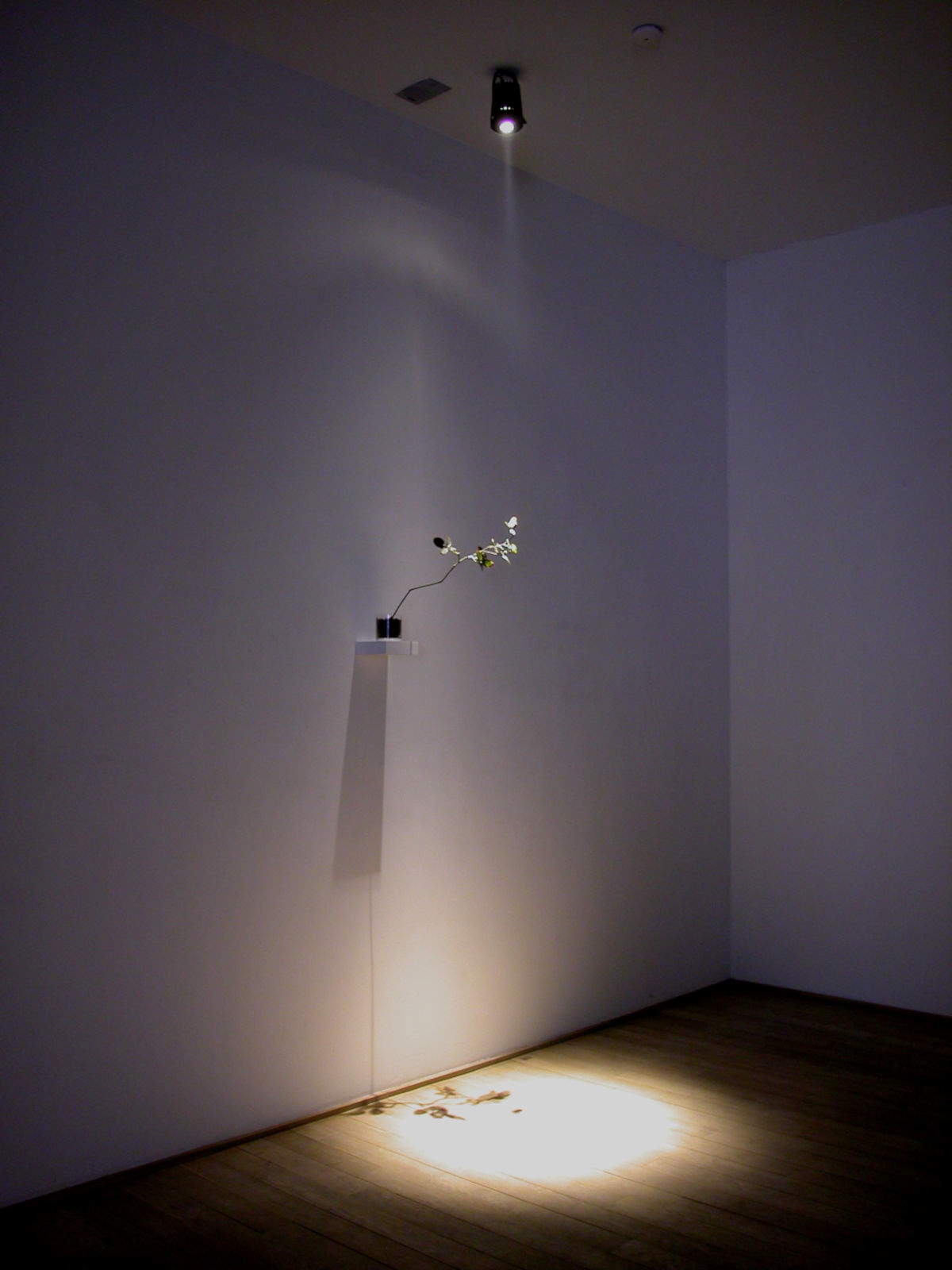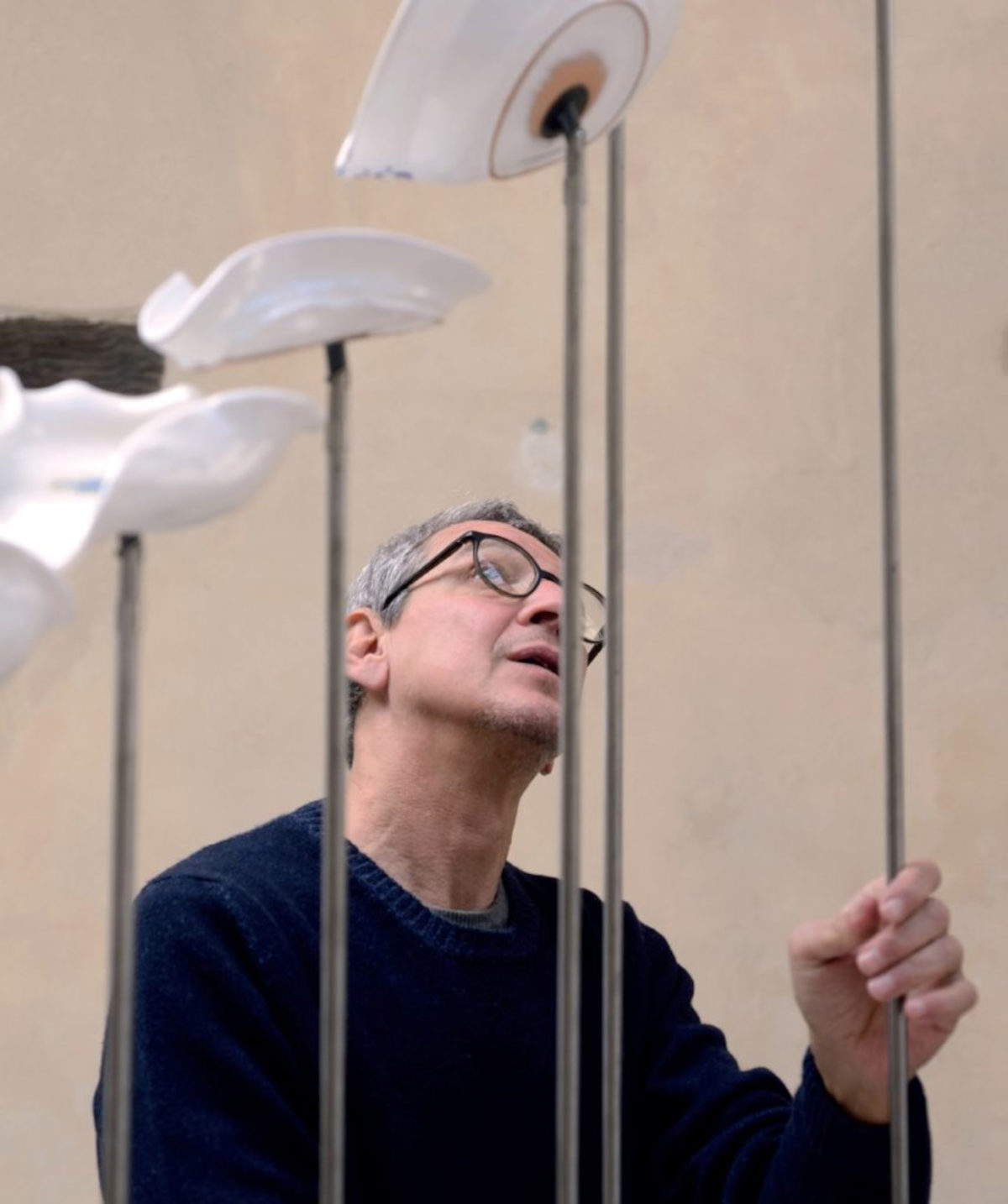An exhibition that relates sound and form, matter and frequency, light and rhythm: Nel mentre, a solo exhibition by artist Mario Airò (Pavia, 1961), will be on view from July 24 to Sept. 15, 2025, at Palazzo Brancadoro, in the historic center of Fermo, Marche. The project is curated by Matilde Galletti and promoted by Karussell, a platform that enhances contemporary art practices in contexts of particular historical and architectural significance.
The exhibition venue, Palazzo Brancadoro, houses Circolo di Ave, a reality known for its activity in the field of classical music. The exhibition fits into this context by immediately highlighting a thematic connection with the musical vocation of the place. In the process, it builds an articulated path through the rooms of the building and proposes a reflection on the concept of harmony, conceived as a generative principle of forms, images and atmospheres.
At the entrance of the building, along the monumental staircase, the visitor encounters Diapason #3, an installation composed of five brass structures two and a half meters high. The work recalls the outline of the tuning fork, the instrument used to tune musical instruments, but modifies its scale, expanding its physical and symbolic perception. Each element contains an absorbent sheet soaked in colored ink, which alludes to the spectral lines of gold’s light emission. The artist translates an electromagnetic frequency into visual terms, suggesting a continuity between the worlds of light and sound, between the physicality of the elements and their invisible energy.

The relationship between music and image is reinforced in the work Estrellita (2003), placed at the entrance to the main floor. A rose, placed in peat inside a glass vase, is crossed by the natural light coming from above, while the eponymous air composed by Manuel Ponce spreads in the space. The result is a strongly evocative composition that interweaves verticality, light and melody in a synaesthetic dialogue.
Continuing along the path, the viewer enters the studiolo, where he or she is confronted with an essential mechanical device: a rudimentary press crushes an upside-down rose, soaked in alcohol, on a score. The flower’s pigments imprint themselves on the musical paper, generating marks with a fragile and spontaneous character. The piece chosen by the artist is Claude Debussy’s Les collines d’Anacapri, whose impressionist suggestions seem to resonate in every detail of the installation. The operation is not limited to a single action: for the duration of the exhibition new scores will be printed, then distributed throughout the spaces, as visual traces of an ephemeral and itinerant harmony.
At the center of the installation, in the Music Room, is Pareidolia capillare, an installation composed of six poplar wood panels. The natural grain of the material is highlighted by light color veiling, transforming the surface into an abstract sound map. The final effect is that of a silent but perceptible rhythm that spreads through the space as a visual echo of the music usually performed in the room. The panels evoke sounds through visual pulsations, as if the wooden structure were vibrating in the same way as a sound box.

Closing the exhibition is the work Anatoma tobeyoides, among the most elusive in the itinerary. It is a completely white panel, traversed by a web of graphic signs that are also white. The effect is that of an apparently monochrome surface, which slowly reveals its details to the visitor only in the presence of a close and attentive gaze. The drawing simulates the outline of a micro-mollusc, suggesting slow, subterranean, minimal movement. The canvas thus becomes a silent score, recording the memory of an organic, imperceptible gesture.
In the process, it develops as a project designed specifically for the environments of Brancadoro Palace and the musical history of the Ave. Circle. The attention to sound, always present in Airò’s research, translates into a poetic exploration of the relationship between frequencies and surfaces, between materials and impalpable phenomena. Without adopting a didactic tone, the project presents itself as an opportunity to observe matter from another perspective: not as a static object, but as a vehicle of vibrations, tensions and memories. The installation lightly traverses the historic spaces and establishes discreet connections with natural light, the materials present, and the original functions of the spaces.
Mario Airò lives and works in Milan, the city that hosted his studios and marked the beginning of his artistic activity, between the late 1980s and the beginning of the following decade. His exhibition career includes numerous solo shows and projects in Italian and international institutions. Venues that have hosted his work include the Antico Mulino Spagnolo in Orbetello (2021), the Fondazione Malvina Menegaz in Castelbasso, in the province of Teramo (2020), the Galleria Nazionale di Parma - Palazzo della Pilotta (2015), the Museo d’Arte Contemporanea Villa Croce in Genoa (2013), the Palazzo della Triennale in Milan (2004), the GAM in Turin (2001), the S.M.A.K. in Ghent, Belgium (2001), the Museum of Contemporary Art in Tokyo (2001) and the Kunsthalle in Lophem, also in Belgium (2000).
His works are part of prestigious public and private collections, including the ArtLine sculpture park in Milan, MAXXI in Rome, Castello di Rivoli Museo d’Arte Contemporanea, GNAM in Rome, MAMbo in Bologna, and Museion in Bolzano. He has also taken part in major international exhibitions, including the Venice Biennale in 1997, the Moscow Biennale of Contemporary Art in 2005, and the Gwangju Biennale in South Korea in 2004. His light installation Cosmometrie is included in the permanent Luci d’Artista project of the city of Turin. Some of his interventions have been made as part of the public commissioning program Nuovi Committenti and the international collective Nouveaux Commanditaires.
 |
| Mario Airò brings the harmony of matter to Fermo's Palazzo Brancadoro with the exhibition "In the While" |
Warning: the translation into English of the original Italian article was created using automatic tools. We undertake to review all articles, but we do not guarantee the total absence of inaccuracies in the translation due to the program. You can find the original by clicking on the ITA button. If you find any mistake,please contact us.